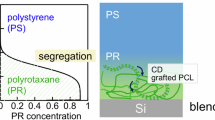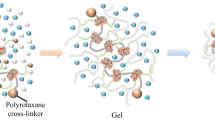Abstract
Polyrotaxane (PR) possesses a supramolecular structure in which cyclic molecules are threaded into an axial polymer. In this study, the static structure of PR dissolved in a good solvent was investigated using contrast variation small-angle neutron scattering. The conformation of the axial linear polymer and the alignment of cyclic molecules within the axial polymer were evaluated quantitatively with the help of a detailed derivation of scattering theory. The decomposed partial scattering functions of the cyclic molecules and the axial polymer and the cross-correlation between cyclic molecules and an axial polymer strongly supported the idea that the alignment of cyclic molecules threaded on the axial polymer is random. On the basis of experimental observation, the entropic origin of the stiffening of PR due to the array of cyclic molecules is discussed.
Similar content being viewed by others
Log in or create a free account to read this content
Gain free access to this article, as well as selected content from this journal and more on nature.com
or
References
Yamakawa, H. Modern Theory of Polymer Solutions (Harper and Row, New York, 1971).
Doi, M & Edwards, S. F The Theory of Polymer Dynamics (Oxford University Press, Oxford, 1988).
Yamakawa, H. Helical Wormlike Chain in Polymer Solutions (Springer-Verlag, Berlin, 1997).
Kuhn, W. Über die Gestalt fadenförmiger Moleküle in Losungen. Kolloid-Z. 68, 2–18 (1934).
Flory, P. J. The configuration of real polymer chains. J. Chem. Phys. 17, 303–310 (1949).
Yamakawa, H. & Fujii, M. Statistical mechanics of helical wormlike chains. I. Differential equations and moments. J. Chem. Phys. 64, 5222–5228 (1976).
Lehn, J. M. Supramolecular chemistry. Science 260, 1762–1763 (1993).
Harada, A., Li, J. & Kamachi, M. The molecular necklace: a rotaxane containing many threaded α-cyclodextrins. Nature 356, 325–327 (1992).
Harada, A., Hashidzume, A., Yamaguchi, H. & Takashima, Y. Polymeric rotaxanes. Chem. Rev. 109, 5974–6023 (2009).
Okumura, Y. & Ito, K. The polyrotaxane gel: a topological gel by figure-of-eight cross-links. Adv. Mater. 13, 485–487 (2001).
Ito, K. Novel cross-linking concept of polymer network: synthesis, structure, and properties of slide-ring gels with freely movable junctions. Polym. J. 39, 489–499 (2007).
Karino, T., Okumura, Y., Ito, K. & Shibayama, M. SANS studies on spatial inhomogeneities of slide-ring gels. Macromolecules 37, 6177–6182 (2004).
Fleury, G., Brochon, C., Schlatter, G., Bonnet, G., Lapp, A. & Hadziioannou, G. Synthesis and characterization of high molecular weight polyrotaxanes: towards the control over a wide range of threaded a-cyclodextrins. Soft Matter 1, 378–385 (2005).
Jarroux, N., Guegan, P., Cheradame, H. & Auvray, L. High conversion synthesis of pyrene end functionalized polyrotaxane based on poly(ethylene oxide) and α-cyclodextrins. J. Phys. Chem. B 109, 23816–23822 (2005).
Travelet, C., Schlatter, G., Hebraud, P., Brochon, C., Lapp, A., Anokhin, D. V., Ivanov, D. A., Gaillard, C. & Hadziioannou, G. Multiblock copolymer behaviour of α-CD/PEO-based polyrotaxanes: towards nano-cylinder self-organization of α-CDs. Soft Matter 4, 1855–1860 (2008).
Mayumi, K., Osaka, N., Endo, H., Yokoyama, H., Sakai, Y., Shibayama, M. & Ito, K. Concentration-induced conformational change in linear polymer threaded into cyclic molecules. Macromolecules 41, 6480–6485 (2008).
Mayumi, K., Endo, H., Osaka, N., Yokoyama, H., Nagao, M., Shibayama, M. & Ito, K. Mechanically interlocked structure of polyrotaxane investigated by contrast variation small-angle neutron scattering. Macromolecules 42, 6327–6329 (2009).
Kratky, O. & Porod, G. Röntgenuntersuchung gelöster Fadenmoleküle. Rec. Trav. Chim. Pays-Bas. 68, 1106–1123 (1949).
Yoshizaki, T. & Yamakawa, H. Scattering functions of wormlike and helical wormlike chains. Macromolecules 13, 1518–1525 (1980).
Endo, H. & Shibayama, M. Static partial scattering functions for linear and ring random copolymers. Polym. J. 42, 157–160 (2010).
Zimm, B. H. The scattering of light and the radial distribution function of high polymer solutions. J. Chem. Phys. 16, 1093–1099 (1948).
Daoud, M., Cotton, P., Farnoux, B., Jannink, G., Sarma, G, Benoit, H., Duplessix, R., Picot, C. & de Gennes, P. G. Solutions of flexible polymers. Neutron experiments and interpretation. Macromolecules 8, 804–818 (1975).
Araki, J., Zhao, C. & Ito, K. Efficient production of polyrotaxanes from a-cyclodextrin and poly(ethylene glycol). Macromolecules 38, 7524–7527 (2005).
Okabe, S., Karino, T., Nagao, M., Watanabe, S. & Shibayama, M. Current status of the 32 m small-angle neutron scattering instrument SANS-U. Nucl. Instrum. Methods Phys. Res. A 572, 853–858 (2007).
Endo, H., Schwahn, D. & Cölfen, H. On the role of block copolymer additives for calcium carbonate crystallization: small angle neutron scattering investigation by applying contrast variation. J. Chem. Phys. 120, 9410–9423 (2004).
Acknowledgements
This work was partially supported by the Ministry of Education, Science, Sports and Culture, Japan (Grant-in-Aid for Scientific Research on Priority Areas, 2006–2010, No. 18068004 and Grant-in-Aid for Scientific Research (S), 2008–2012, No. 20221005). The SANS experiment was performed with the approval of the Institute for Solid State Physics, The University of Tokyo, at the Japan Atomic Energy Agency, Tokai, Japan (Proposal No. 7607).
Author information
Authors and Affiliations
Corresponding authors
Appendix A
Appendix A
Form factor of a discrete rod
The scattering amplitude of a rod of length L is given by

where the classic coordinate system with the z axis in the direction of the vector Q (Q·r=Qr cosθ) is used. Then, an analytical form of the form factor of the rod can be obtained:

which is identical to Equation (5).
We discretize Equation (A1) by assuming that the rod consists of monomer-A and monomer-B, where the total number of monomers is n0 and the length of one monomer unit is L/n0. The discretization proceeds as follows:

Therefore, the corresponding form factor of a discrete rod composed of monomer-A is obtained by

with the n0-dimensional vector Am/n(k) defined by Equation (8). In the case of a purely random process for the distribution of monomer-A, Am/n(k) can be substituted by the ensemble average defined by Equation (9); then, an analytic form of Equation (A4) can be derived as

where PR(x)=2Si(x)/x−{sin(x)/x}2 with the sine integral Si(x).
In the case of a discrete cylinder with base radius R and length L, instead of the discrete rod, Equation (A4) is modified as

where PDisk(x)={2J1(x)/x}2 with the first-order cylindrical Bessel function J1(x). For hollow cylindrical objects such as cyclic molecules, PDisk(x) can be substituted by

where Rin is the internal radius and Rout is the external radius. For the purely random process of the distribution of monomer-A, Equation (A6) can be reduced to

Rights and permissions
About this article
Cite this article
Endo, H., Mayumi, K., Osaka, N. et al. The static structure of polyrotaxane in solution investigated by contrast variation small-angle neutron scattering. Polym J 43, 155–163 (2011). https://doi.org/10.1038/pj.2010.124
Received:
Revised:
Accepted:
Published:
Issue date:
DOI: https://doi.org/10.1038/pj.2010.124
Keywords
This article is cited by
-
Optimal conditions for the use of polyrotaxane as a cross-linker in preparing elastomers with high toughnesses
Polymer Journal (2024)
-
Molecular dynamics and structure of polyrotaxane in solution
Polymer Journal (2021)
-
Cyclodextrin-based rotaxanes
Journal of Inclusion Phenomena and Macrocyclic Chemistry (2012)



